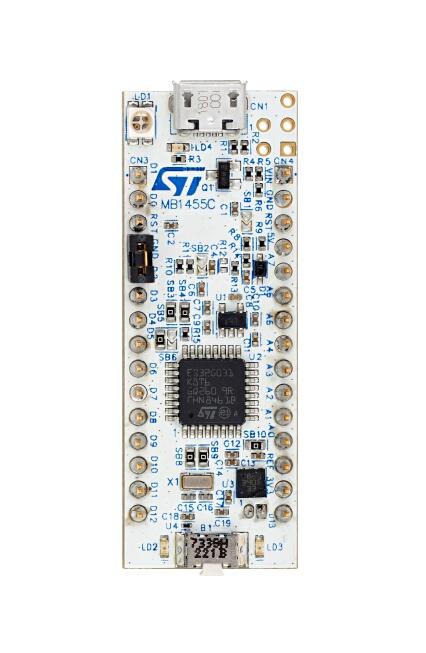ST Nucleo G031K8
Overview
The STM32 Nucleo-32 board provides an affordable and flexible way for users to try out new concepts and build prototypes by choosing from the various combinations of performance and power consumption features, provided by the STM32 microcontroller.
The Arduino™ Nano V3 connectivity support allows the easy expansion of the functionality of the STM32 Nucleo open development platform with a wide choice of specialized shields.
The STM32 Nucleo-32 board does not require any separate probe as it integrates the ST-LINK debugger/programmer.
The STM32 Nucleo-32 board comes with the STM32 comprehensive free software libraries and examples available with the STM32Cube MCU Package.

More information about the board can be found at the Nucleo G031K8 website [1].
Hardware
Nucleo G031K8 provides the following hardware components:
STM32 microcontroller in 32-pin package featuring 64 Kbytes of Flash memory and 8 Kbytes of SRAM.
Extension resource:
Arduino* Nano V3 connectivity
On-board ST-LINK/V2-1 debugger/programmer with SWD connector:
Flexible board power supply:
USB VBUS or external source (3.3V, 5V, 7 - 12V)
Current consumption measurement (IDD)
Four LEDs:
USB communication (LD1), power LED (LD2), user LED (LD3), USB power fault LED (LD4)
One push-button: RESET
USB re-enumeration capability. Three different interfaces supported on USB:
Virtual COM port
Mass storage
Debug port
More information about STM32G031K8 can be found in the STM32G0x1 reference manual [2]
Supported Features
The Zephyr nucleo_g031k8 board configuration supports the following hardware features:
Interface |
Controller |
Driver/Component |
|---|---|---|
NVIC |
on-chip |
nested vector interrupt controller |
UART |
on-chip |
serial port-polling; serial port-interrupt |
PINMUX |
on-chip |
pinmux |
GPIO |
on-chip |
gpio |
CLOCK |
on-chip |
reset and clock control |
I2C |
on-chip |
i2c controller |
SPI |
on-chip |
spi controller |
Other hardware features are not yet supported in this Zephyr port.
The default configuration can be found in the defconfig file: boards/st/nucleo_g031k8/nucleo_g031k8_defconfig
Connections and IOs
Each of the GPIO pins can be configured by software as output (push-pull or open-drain), as input (with or without pull-up or pull-down), or as peripheral alternate function. Most of the GPIO pins are shared with digital or analog alternate functions. All GPIOs are high current capable except for analog inputs.
Default Zephyr Peripheral Mapping:
UART_2 TX/RX : PA2/PA3 (ST-Link Virtual Port Com)
I2C2 SCL/SDA : PA9/PA10 (Arduino I2C)
SPI1 SCK/MISO/MOSI : PB3/PB4/PB5 (Arduino SPI)
LD3 : PC6
For more details please refer to STM32 Nucleo-32 board User Manual [3].
Programming and Debugging
Applications for the nucleo_g031k8 board configuration can be built and
flashed in the usual way (see Building an Application and
Run an Application for more details).
Flashing
Nucleo G031K8 board includes an ST-LINK/V2-1 embedded debug tool interface. This interface is supported by the openocd version included in the Zephyr SDK.
Flashing an application to Nucleo G031K8
Here is an example for the Blinky application.
# From the root of the zephyr repository
west build -b nucleo_g031k8 samples/basic/blinky
west flash
You will see the LED blinking every second.
Debugging
You can debug an application in the usual way. Here is an example for the Hello World application.
# From the root of the zephyr repository
west build -b nucleo_g031k8 samples/hello_world
west debug
Restriction
On some boards, the board reset line is not used by the controller. Therefore the reset button, reset-pin and the ST-Link reset have no effect. To enable those functionalities, the option byte NRST_mode in the User Configuration needs to be changed from 2 to 1 or 3 - depending on the requirements.